Spring is for the Jacaranda
in purple, woken up cold
For the Flame-of-the-forest
in red, in its loosening hold.
When you let go of me, I saw
your coral fingers uncurl in
the petal of a Tiger’s Claw.
Summer is for the Gulmohar
in orange, too hurt to calm
For the unkempt Bougainvillea
in colours of unloved charm.
But the season of defeat for
the Amaltas heart is in yellow.
I succumb, become laburnumb.
India’s diverse climate allows for a variety of beautiful flowering trees that bloom in the summer. Here are ten notable ones:India’s diverse climate allows for a variety of beautiful flowering trees that bloom in the summer. Here are a few notable ones:
Amaltas/ Golden Shower
Botanical Name – Cassia fistula

Also, known as the Golden Shower or rain tree, as it produces pendulous, bright golden-yellow flowers that hang in long, cascading clusters. Cassia fistula is also known as The Indian laburnum, the most prominent cassia native to the Indian Subcontinent. It is a great source of herbal medicine as well as a very popular for ornamental purposes. During the summertime, this tree blooms full of its golden yellow, mildly scented flowers.
“First come the purple flowers of the jacaranda.
They are followed by the red of the gulmohar.
And then arrives the yellow and golden amaltas.
These flowers sprout from under the armpits of every branch;
their color is so gentle
that the heat becomes transparent
so it doesn’t hurt you so much.
The flowers hang down in bunches
above you like nature’s blessings…
Otherwise, there is no heaven waiting for us in this heat.”
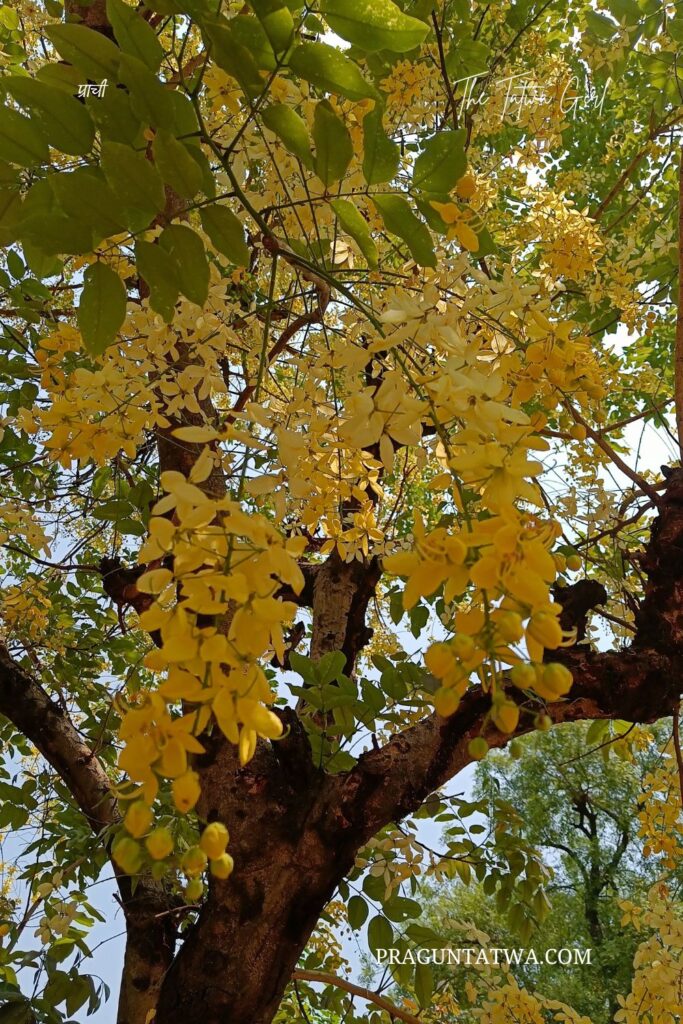
Buransh Flowers
Botanical Name – Rhododendron arboreum

)
The buraansh flower, also known as Rhododendron, is a bright red flower that blooms in the Himalayas. It’s the state flower of Himachal Pradesh and Nagaland, and the state tree of Uttarakhand.
-
The word Rhododendron comes from the Greek words rhodo, meaning “rose”, and dendron, meaning “tree”
-
The buraansh flower is known for its medicinal and therapeutic properties
-
It’s also used to make a popular squash and juice
-
The buraansh flower blooms after long, harsh winters
-
It represents hope and resilience of the Pahadi people
- Buraansh salt masala can be used to season salads, fruits, chips, nuts, or popcorn
- It can also be used to enhance the flavor of Indian street food snacks
- Buraansh squash can be made into a natural cooler.
Champak Tree/ Frangipani/ Plumeria/ Chafa
Scientific name – Michelia champaca


The Champaka flower, also known as Michelia champaca, is a species of flowering tree in the family Magnoliaceae. It is native to Southeast Asia and is particularly valued for its fragrant yellow-orange blooms or white flowers. Other names include – Frangipani/ Plumeria/ Chafa
Here are some key points about the Champaka flower:
- Fragrance: The flowers are highly aromatic and are often used in perfumes and traditional ceremonies. Their scent is sweet and can be quite intense.
- Cultural Significance: In many cultures, especially in India and other parts of Asia, Champaka flowers hold religious significance. They are often used in Hindu rituals and are associated with love and beauty.
- Botanical Characteristics: A full sized evergreen tree can grow up to 30 meters – 55 meters tall and has large, glossy leaves. The flowers typically bloom in the spring and summer months.
- Uses: Beyond ornamental uses, parts of the tree may also be used in traditional medicine, and the wood is valued for its durability and beauty. For the longest period, Champak trees have been used to produce aromatic hair and massage oils.
Champaka flowers are appreciated for their beauty and fragrance, making them a popular choice in gardens and landscapes where they can thrive. This tall, evergreen tree was grown for both decorative and therapeutic purposes. It yields fragrant flowers that are frequently utilised in both Indian religious rituals and the treatment of leprosy.
Kapok/ Silk Cotton tree
Scintific Name – Bombax Ceiba
Bombax Ceiba is the scientific name for the Silk Cotton tree/Red Cotton tree. More specifically, it is sometimes known as Malabar silk-cotton tree; red silk-cotton; red cotton tree; or ambiguously as silk-cotton or Kapok, both of which may also refer to Ceiba pentandra.
It is a big, commanding deciduous tree that sheds its leaves every year. This tree is frequently cultivated as an ornamental to improve the local scenery. As the name implies, it quickly grows fragrant red blossoms after losing its leaves. During the months of March and April, this tree yields fruits and cotton.


Locals in India use this cotton to fill cushions and couches. While, the fruit can be pickled or cooked like a vegetable. In Hindi, the tree is widely referred to as Semal. Additionally praised for their therapeutic qualities are the red cotton trees. It is thought to be beneficial for conditions including toothaches, fractures, gonorrhoea, snakebite, cholera, ulcer, etc.
Kachnar Tree
Scientific name – Bauhinia variegata/ Bauhinia blakeana


A deciduous tree called kachnar blooms with purple flowers in the later winter months. Various other names for the kachnar tree include butterfly ash, hong kong orchid tree, poor man’s orchid, camel’s foot, mountain ebony, रक्त कंचन कचनार, and orchid tree. The orchid tree, as it is also known, has beautiful pink, white, or purple flowers that resemble orchids.
The Kachnar tree’s blossoms and buds are edible and a good source of vitamin C. The blossoms are used as herbs in Ayurveda to heal wounds, fever, thyroid problems, inflammation, and many other conditions.
Gulmohar
Scientific Name – Delonix regia
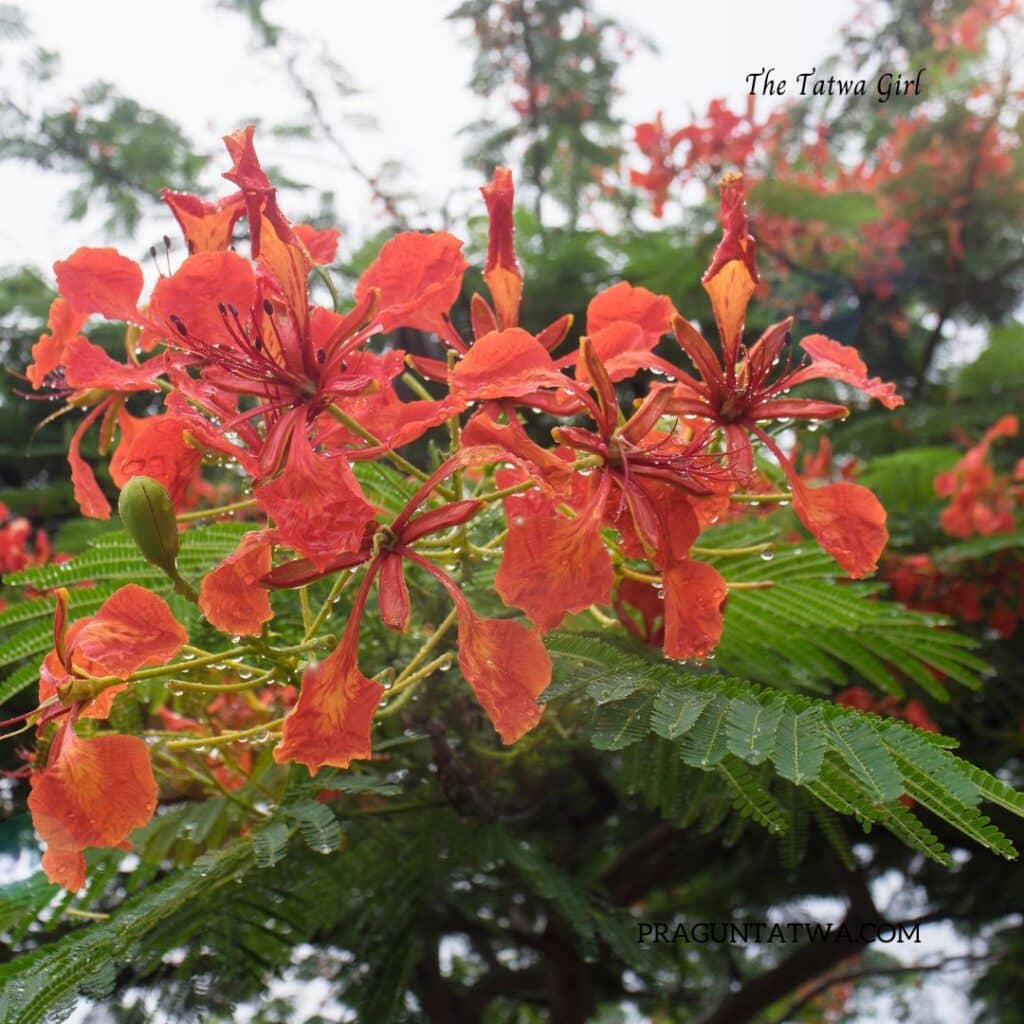
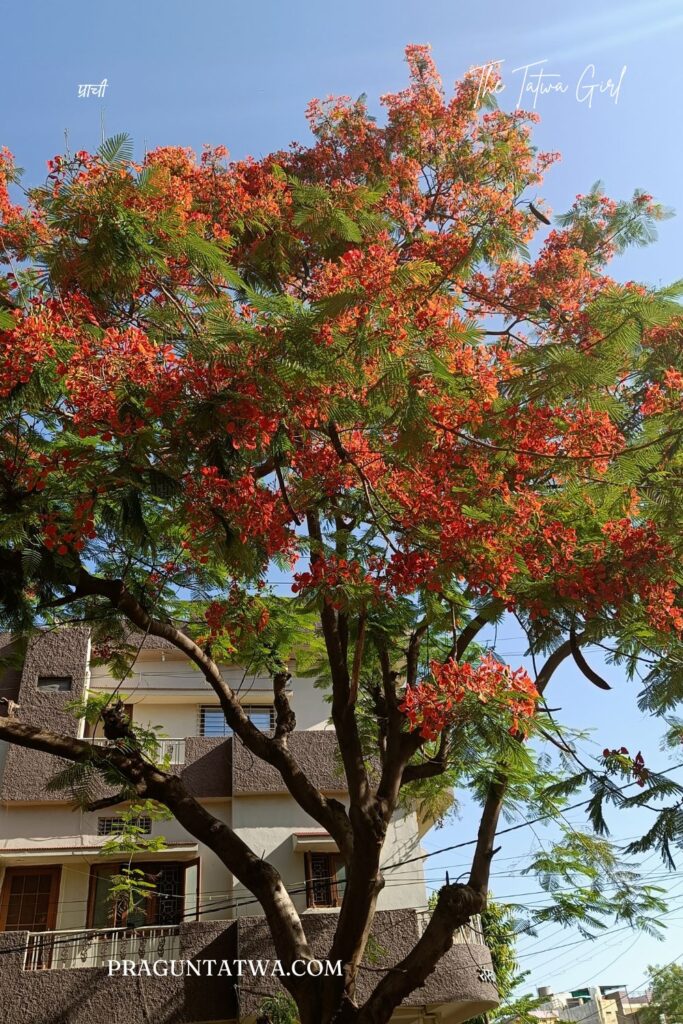
Known for its strikingly vibrant red and orange flowers, the Gulmohar is one of the most eye-catching summer bloomers.
The first blooming tree that springs to mind is the gulmohar tree. mostly because I have childhood recollections of playing games and having fun by sticking its flower buds on my nails.
This magnificent flowering tree has light, fluffy green leaves and bright red, orange, and purple blossoms.
- The flowers have four spreading petals and one upright petal
- The upright petal is slightly larger and has white and yellow spots
- The flowers grow in corymbs at the ends and along branches
- The tree is used as an ornamental tree in tropical parts of the world
- The tree’s stem, bark, leaves, flower, and seeds are used in Ayurvedic and traditional medicine
Indian Cork Tree
Scintific name – Millingtonia hortensis


This tree has fragrant white flowers that bloom in clusters, often used in traditional garlands. These white flowering ornamental tree flowers are often used in veni in Maharashtra and southern India.
The Indian Cork Tree, renowned for its unique bark and ecological importance, is a striking addition to the landscapes of India. Scientifically known as Millingtonia hortensis, this tree is characterized by its tall stature, fragrant flowers, and distinctive cork-like bark, which serves various practical purposes.
The Indian Cork Tree not only enhances the beauty of gardens and parks but also plays a crucial role in supporting local biodiversity.
- It is also known as Tree Jasmine, Indian Cork Tree is a long deciduous tree.
- This is grown in gardens and avenues for its perfuming flowers.
- This is a fast-growing tree. Indigenous (native to India)
- Its long tubular, white, and fragrant flowers bloom at night and shed early in the morning.
- It flowers in June, July, August, September, October, November.
- It is a big tree, can spread & grow up to 12 meters.
- Good for screening, recommended for creating shade.
Palash/ Tesu/ Dhak
Scientific Name – Butea monosperma


It is also known as Flame of the Forest, Bengal kino, dhak, palash, and bastard teak, this tree blooms with bright orange-red flowers.
The flowers of this colorful tree are large & crowded on leafless branches. These blooms are a bright flaming scarlet orange, with a shape resembling a Parrot’s beak. The flowers yield dye which is used a natural color during ‘Holi’ celebrations. The palash tree’s flowers bloom in clusters in February and March. The flowers bloom after the tree sheds its leaves
- The palash tree is small to medium-sized and deciduous
- It has dark greyish bark, an asymmetrical trunk, and irregularly spread branches
- The tree’s leaves are broad and round
- The flowers, bark, leaves, and seeds of the palash tree are used for medicinal purposes
- The flowers and leaves have astringent properties that help control pimples and boils
- The tree has diuretic properties that increase urine production
- The tree has aphrodisiac properties that help improve sexual performance
- The tree’s flowers are used to treat stomach infections and alleviate diabetes symptoms.
Rose of Sharon tree
Botanical name: Hibiscus syriacus
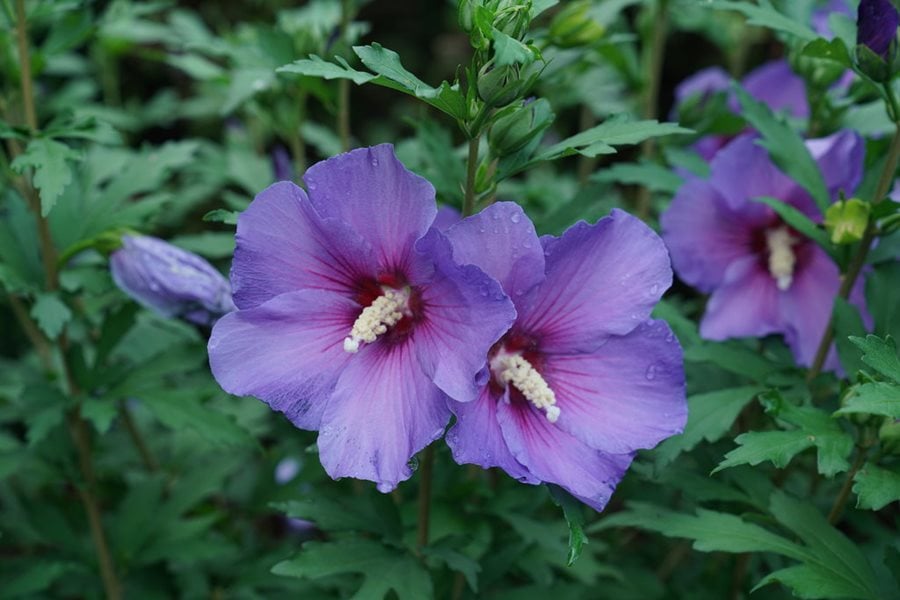
- Large, trumpet-shaped flowers that come in white, pink, red, purple, or violet
- Medium to dark green leaves with a coarsely toothed margin
- Vase-shaped growth habit
- Grows in sun or partial shade
- Grows in any soil, including poor soil, heavy clay, and salt
- Tolerates heat, humidity, drought, and air pollution
- Prefers full sun and well-drained soil
- Easy to grow and low maintenance
- Needs supplemental watering during the first year, especially in dry summers
- Pruning is not required, but it does encourage more blooming
- Trim some old, woody branches back to the ground every year in late winter or early spring
- Can be used as a garden accent
- Can be pruned to create a single-trunked, small specimen tree
- Can be planted 2–3′ apart to create a single row hedge
- The rose of sharon is the national flower of South Korea.
- In the United Kingdom, it’s called Rose Mallow.
- In Italy, it’s called St. Joseph’s Rod.
Rose of Sharon falls under the genus Hibiscus, making it a cousin of other popular Hibiscus varieties. Essentially, all Rose of Sharons are Hibiscus, but not all Hibiscus are Rose of Sharons. The plant traditionally labeled ‘Hibiscus’ as a common name is actually called Chinese Hibiscus, or Rose of China.
For spectacular flowers and easy care, plant your Rose of Sharon in a spot with good drainage and full sun to partial shade. In northern climates, six or more hours of direct daily sun promotes maximum blooms.
The rose-of-sharon is native to China and India. The name hibiscus is from an ancient Greek name for “mallow,” for this plant was thought to resemble the mallow blossom.
Pride of India
Scientific Name – Lagerstroemia speciose
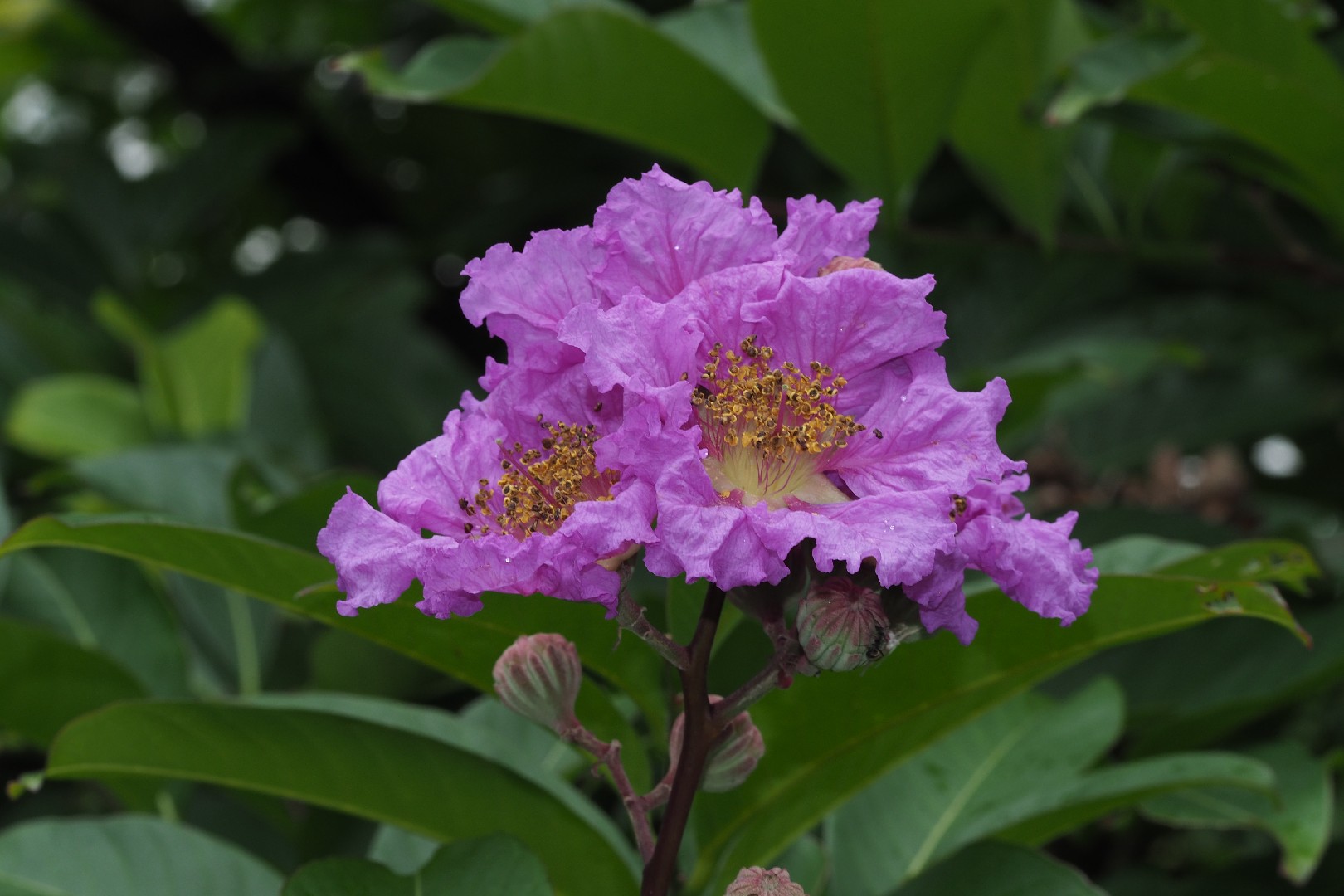
Lagerstroemia Speciosa (no, that’s not a magical spell) also recognized as Pride of India is an evergreen tree famous for its vivid purple and pink blooms. These outstanding summer blooms are Famous in the state of Maharashtra where it is known as Tamhan. This tree has showy mauve flowers which bloom from April to May and July to August. They grow about 30 cm panicles at the end of the branches and are considered in Buddhism.
In addition to its attractiveness, it is sold economically for its high-quality wood bark. Some people utilise the leaves of this tree for medicinal purposes, particularly in the Philippines. It is thought to help renal and diabetic conditions. The fruits of this tree are used as a remedy for mouth ulcers in India. Its seeds are said to be narcotic, while its roots work well as astringents.
Rain Tree
Common name: Rain Tree, Coco tamarind, Acacia preta, French tamarind, Saman, Monkey pod • Hindi: गुलाबी सिरिस Gulabi Siris, Vilaiti siris.
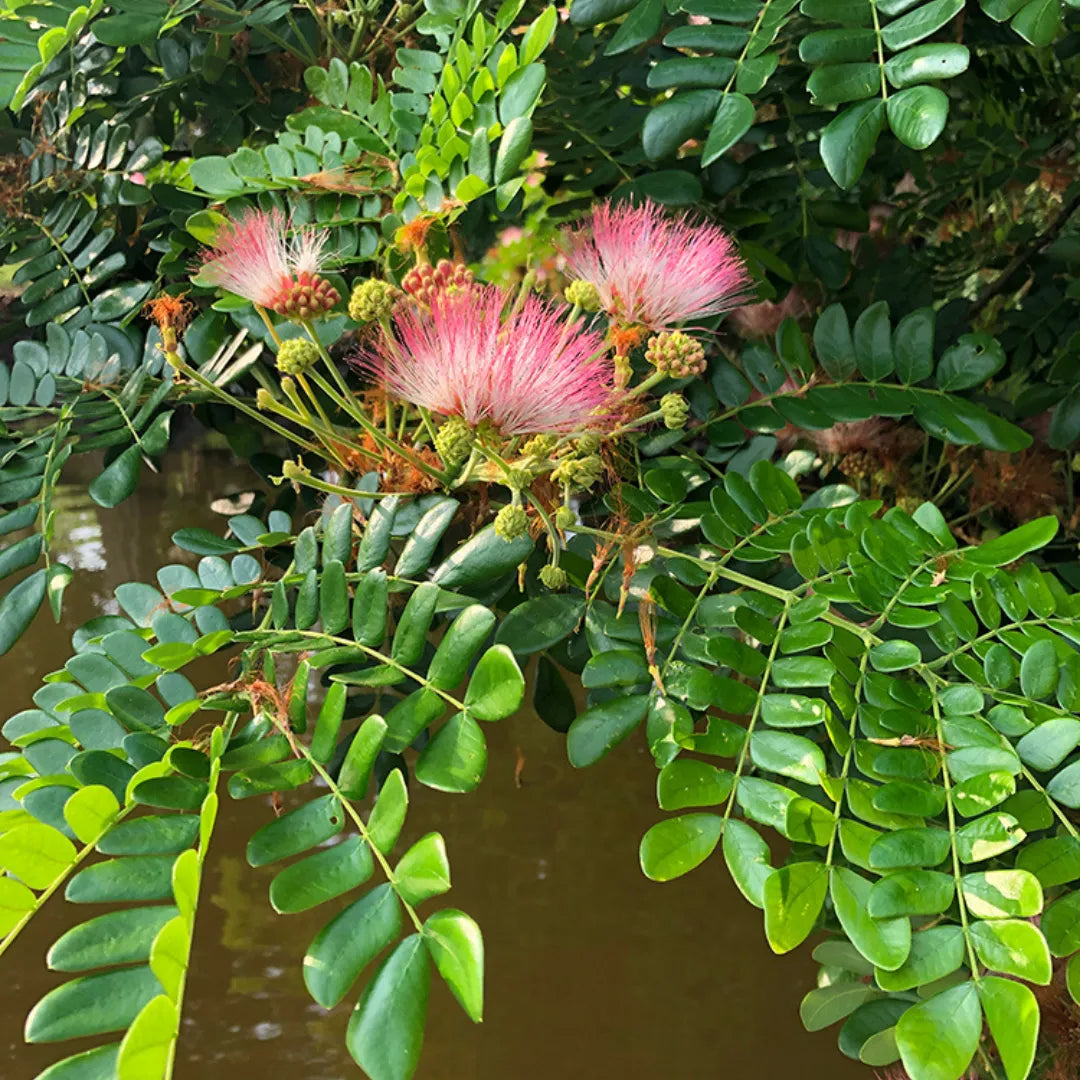

The rain tree (Samanea saman) is a flowering tree with a large canopy that’s native to central and south america. It’s also known as the monkey pod tree. From March to May and again towards the end of the year the green canopy is dotted all over with pink and white. During the rest of the year, too, there are usually quite a few flowers to be seen.
- The rain tree is a fast-growing tree that can reach heights of 45 meters.
- The most widespread blooming tree in India is the rain tree, which is also planted along roadsides as a valuable shade tree.
- It has a wide, low, spreading crown that’s often twice as wide as it is high.
- The rain tree’s bark is grey-brown, rough, and furrowed into ridges.
- The rain tree’s leaves fold up when it’s cloudy.
- The rain tree’s large branches have velvety and hairy bark and can break off during rainstorms.
- This beautiful tree has slender branches, a broad canopy, and pink blossoms. This tree was imported to Sri Lanka from Central America and subsequently transported to India. This tree’s wood was renowned for making excellent steam fuel for railroad locomotives.
- The rain tree is often planted as a shade tree and ornamental.
- The rain tree’s pods are palatable to animals and contain a sweet edible pulp.
- The rain tree is valued in pastures as shade for cattle.
- The rain tree is also known as Samanea, Pithecellobium, and Monkey pod.
- The rain tree is commonly used for avenue plantation.
Jacaranda Tree/ Neeli Gulmohar
Botanical name – Jacaranda mimosifolia

Jacaranda mimosifolia, locally known as ‘Neeli Gulmohar’, is a medium-sized, deciduous tree with finely cut foliage and showy tubular, bell-shaped mauve-blue flowers. Jacaranda mimosifolia, commonly known as the Jacaranda or the Blue Jacaranda, is a stunning flowering tree native to South America.
The blooming of Jacaranda trees is not just a visual spectacle; it’s a poetry of seasons. In regions where the Jacaranda thrives, its blossoming marks the arrival of spring or summer. The sight of these lavender blooms against a clear blue sky elicits a sense of renewal and vitality, bringing a touch of magic to even the most mundane urban landscapes. Streets lined with Jacaranda trees become avenues of wonder, where nature’s artistry meets human ingenuity.
These trees not only add beauty to the landscape but also provide shade and habitat for various species, contributing to the ecological richness of the region.
The Jacaranda isn’t just a pretty face in the botanical world; it plays an essential ecological role too. Its nectar-rich flowers attract pollinators like bees and butterflies, contributing to local biodiversity. The tree’s fallen blossoms also enrich the soil with nutrients as they decompose, fostering a healthy ecosystem around it.

These Jacaranda blooms are from my favourite place Wellington, Nilgiri Mountains.
What flowers boom in yoru area? Do share in comments.

I am linking this to #SkywatchFriday— a “not for profit, not for awards” fun place to post and link from, where you will find some amazing sky photographs worldwide. You might also like to see my Tree Love in these Tree Posts:
- Did you hug a tree today?
- October Flowers of Parijaat
- Frangipani/ Chafa/ Plumeria
- A beautiful flowering Mango Tree
- The Vivid Gulmohar Tree
- X-mas Tree — That kept me sane in lockdown


- Agni (Fire): Recipes & culinary creations, inspired by Agni’s energy and lifeforce.
- Vayu (Air): Festivals, culture, & traditions, everything around us like beliefs and mythology.
- Aakash (Sky): Travel tales under infinite skies, and my journey experiences.
- Jal (Water): Flowing thoughts & emotions, like water are my flow of thoughts.
- Prithvi (Earth): Eco-friendly living & sustainability, and harmony of our greener planet.







Leave a Reply